Tunable Plasmonic Band-Pass Filter with Dual Side-Coupled Circular Ring Resonators
Abstract
:1. Introduction
2. Model and Theoretical Analysis
3. Results and Discussion
4. Conclusions
Acknowledgments
Author Contributions
Conflicts of Interest
References
- Barnes, W.L.; Dereux, A.; Ebbesen, T.W. Surface plasmon subwavelength optics. Nature 2003, 424, 824–830. [Google Scholar] [CrossRef] [PubMed]
- Genet, C.; Ebbesen, T.W. Light in tiny holes. Nature 2007, 445, 39–46. [Google Scholar] [CrossRef] [PubMed]
- Neutens, P.; Dorpe, P.V.; Vlaminck, I.D.; Lagae, L.; Borghs, G. Electrical detection of confined gap plasmons in metal-insulator-metal waveguides. Nat. Photonics 2009, 3, 283–286. [Google Scholar] [CrossRef]
- Gramotnev, D.K.; Bozhevolnyi, S.I. Plasmonics beyond the diffraction limit. Nat. Photonics 2010, 4, 83–91. [Google Scholar] [CrossRef]
- Liu, D.D.; Sun, Y.; Fan, Q.B.; Mei, M.F.; Wang, J.C.; Pan, Y.W.; Lu, J. Tunable plasmonically induced transparency with asymmetric multi-rectangle resonators. Plasmonics 2016, 11, 1621–1628. [Google Scholar] [CrossRef]
- Lin, X.S.; Huang, X.G. Tooth-shaped plasmonic waveguide filters with nanometeric sizes. Opt. Lett. 2008, 33, 2874–2876. [Google Scholar] [CrossRef] [PubMed]
- Lee, T.; Lee, D.; Kwon, S. Dual-function metal-insulator-metal plasmonic optical filter. IEEE Photonics J. 2015, 7, 4800108. [Google Scholar] [CrossRef]
- Zand, I.; Bahramipanah, M.; Abrishamian, M.S.; Liu, J.M. Metal-insulator-metal nanoscale loop-stub structures. IEEE Photonics J. 2012, 4, 2136–2142. [Google Scholar] [CrossRef]
- Lu, H.; Liu, X.M.; Mao, D.; Wang, L.R.; Gong, Y.K. Tunable band-pass plasmonic waveguide filters with nanodisk resonators. Opt. Express 2010, 18, 17922–17927. [Google Scholar] [CrossRef] [PubMed]
- Tao, J.; Wang, Q.J.; Huang, X.G. All-optical plasmonic switches based on coupled nano-disk cavity structures containing nonlinear material. Plasmonics 2011, 6, 753–759. [Google Scholar] [CrossRef]
- Liu, H.Q.; Gao, Y.X.; Zhu, B.F.; Ren, G.B.; Jian, S.S. A T-shaped high resolution plasmonic demultiplexer based on perturbations of two nanoresonators. Opt. Commun. 2015, 334, 164–169. [Google Scholar] [CrossRef]
- Wang, G.X.; Lu, H.; Liu, X.M.; Mao, D.; Duan, L.N. Tunable multi-channel wavelength demultiplexer based on MIM plasmonic nanodisk resonators at telecommunication regime. Opt. Express 2011, 19, 3513–3518. [Google Scholar] [CrossRef] [PubMed]
- Wu, T.S.; Liu, Y.M.; Yu, Z.Y.; Peng, Y.W.; Shu, C.G.; Ye, H. The sensing characteristics of plasmonic waveguide with a ring resonator. Opt. Express 2014, 22, 7669–7677. [Google Scholar] [CrossRef] [PubMed]
- Lin, Q.; Zhai, X.; Wang, L.L.; Luo, X.; Liu, G.D.; Liu, J.P.; Xia, S.X. A novel design of plasmon-induced absorption sensor. Appl. Phys. Express 2016, 9, 062002. [Google Scholar] [CrossRef]
- Qu, S.N.; Song, C.; Xia, X.S.; Liang, X.Y.; Tang, B.J.; Hu, Z.D.; Wang, J.C. Detuned plasmonic Bragg grating sensor based on defect metal-insulator-metal waveguide. Sensors 2016, 16, 784. [Google Scholar] [CrossRef] [PubMed]
- Qian, Q.L.; Liang, Y.J.; Liang, Y.; Shao, H.Y.; Zhang, M.L.; Xiao, T.; Wang, J.C. Tunable multiple-step plasmonic Bragg reflectors with graphene-based modulated grating. Sensors 2016, 16, 2039. [Google Scholar] [CrossRef] [PubMed]
- Zhan, G.Z.; Liang, R.S.; Liang, H.T.; Luo, J.; Zhao, R.T. Asymmetric band-pass plasmonic nanodisk filter with mode inhibition and spectrally splitting capabilities. Opt. Express 2014, 22, 9912–9919. [Google Scholar] [CrossRef] [PubMed]
- Lu, H.; Liu, X.M.; Mao, D. Plasmonic analog of electromagnetically induced transparency in multi-nanoresonator-coupled waveguide systems. Phys. Rev. A 2012, 85, 053803. [Google Scholar] [CrossRef]
- Wei, W.; Zhang, X.; Ren, X.M. Plasmonic circular resonators for refractive index sensors and filters. Nona. Res. Lett. 2015, 10, 211. [Google Scholar] [CrossRef] [PubMed]
- Xie, Y.Y.; Huang, Y.X.; Zhao, W.L.; Xu, W.H.; He, C. A novel plasmonic sensor based on metal-insulator-metal waveguide with side-coupled hexagonal cavity. IEEE Photonics J. 2015, 7, 4800612. [Google Scholar] [CrossRef]
- Bahramipanah, M.; Abrishamian, M.S.; Mirtaheri, S.A.; Liu, J.M. Ultracompact plasmonic loop-stub notch filter and sensor. Sens. Actuators B 2014, 194, 311–318. [Google Scholar] [CrossRef]
- Zou, S.W.; Wang, F.Q.; Liang, R.S.; Xiao, L.P.; Hu, M. A nanoscale refractive index sensor based on asymmetric plasmonic waveguide with a ring resonator: A review. IEEE Sens. J. 2015, 15, 646–650. [Google Scholar] [CrossRef]
- Zhang, H.Y.; Shen, D.L.; Zhang, Y.P. Circular split-ring core resonators used in nanoscale metal-insulator-metal band-stop filters. Laser Phys. Lett. 2014, 11, 115902. [Google Scholar] [CrossRef]
- Zhang, S.; Genov, D.A.; Wang, Y.; Liu, M.; Zhang, X. Plasmon-induced transparency in metamaterials. Phys. Rev. Lett. 2008, 101, 047401. [Google Scholar] [CrossRef] [PubMed]
- Huang, B.; Meng, H.Y.; Wang, Q.H.; Wang, H.H.; Zhang, X.; Yu, W.; Tan, C.H.; Huang, X.G.; Wang, F.Q. Plasmonic-induced transparency and slow-light effect based on stub waveguide with nanodisk resonator. Plasmonics 2016, 11, 543–550. [Google Scholar] [CrossRef]
- He, Z.; Li, H.; Zhan, S.; Cao, G.; Li, B. Combined theoretical analysis for plasmon-induced transparency in waveguide systems. Opt. Lett. 2014, 39, 5543–5546. [Google Scholar] [CrossRef] [PubMed]
- Liu, D.D.; Fan, Q.B.; Mei, M.F.; Wang, J.C.; Pan, Y.W.; Teng, D.X.; Lu, J. Tunable multiple plasmon-induced transparency with side-coupled rectangle cavities. Chin. Opt. Lett. 2016, 14, 052302. [Google Scholar]
- Wen, K.H.; Hu, Y.H.; Chen, L.; Zhou, J.Y.; He, M.; Lei, L.; Meng, Z.M. Plasmonic-Induced Absorption and Transparency Based on a Compact Ring-Groove Joint MIM Waveguide Structure. IEEE Photonics J. 2016, 8, 4802308. [Google Scholar] [CrossRef]
- Li, H.J.; Wang, L.L.; Zhai, X. Plasmonically induced absorption and transparency based on MIM waveguides with concentric nanorings. IEEE Photonics Technol. Lett. 2016, 28, 1454–1457. [Google Scholar] [CrossRef]
- Liu, D.D.; Pan, Y.W.; Sun, Y.; Xia, X.S.; Wang, J.C.; Lu, J. Tunable multimode electromagnetically induced absorption transmission in metal-insulator-metal resonators. AIP Adv. 2016, 6, 025219. [Google Scholar] [CrossRef]
- Wen, K.H.; Hu, Y.H.; Zhou, J.Y.; Lei, L.; Li, J.F.; Wu, Y.J. Plasmonic-induced absorption in an end coupled metal-insulator-metal resonator structure. Opt. Mater. Express 2017, 7, 433–443. [Google Scholar] [CrossRef]
- Wen, K.; Hu, Y.; Chen, L.; Zhou, J.; Lei, L.; Guo, Z. Fano resonance with ultra-high figure of merits based on plasmonic metal-insulator-metal waveguide. Plasmonics 2015, 10, 27–32. [Google Scholar] [CrossRef]
- Wen, K.; Hu, Y.; Chen, L.; Zhou, J.; Lei, L.; Meng, Z. Single/dual Fano resonance based on plasmonic metal-dielectric-metal waveguide. Plasmonics 2016, 11, 315–321. [Google Scholar] [CrossRef]
- Haus, H.; Huang, W.P. Couple-mode theory. Proc. IEEE 1991, 79, 1505–1518. [Google Scholar] [CrossRef]
- Li, Q.; Wang, T.; Su, Y.; Yan, M.; Qiu, M. Coupled mode theory analysis of mode-splitting in coupled cavity system. Opt. Express 2010, 18, 8367–8382. [Google Scholar] [CrossRef] [PubMed]
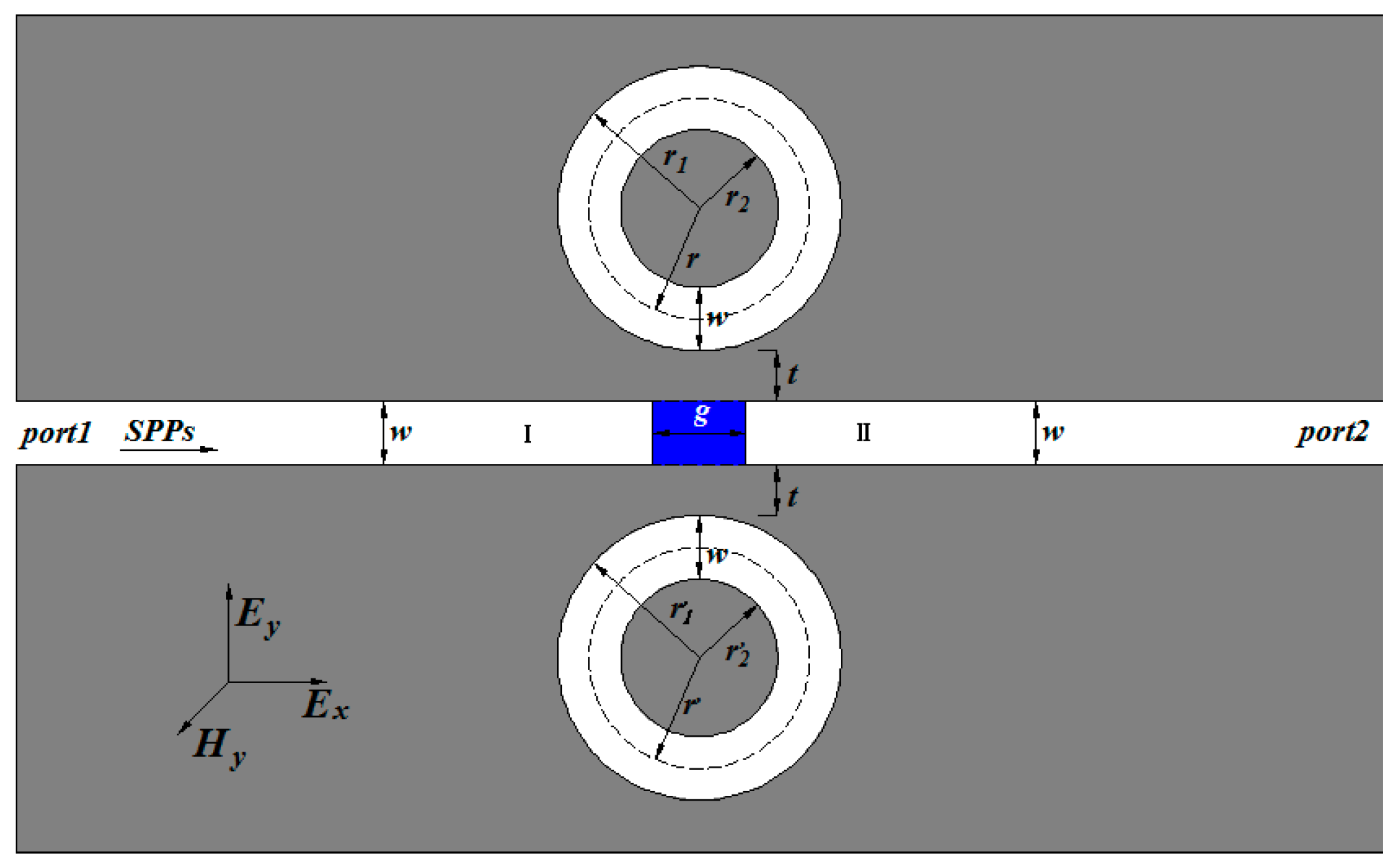
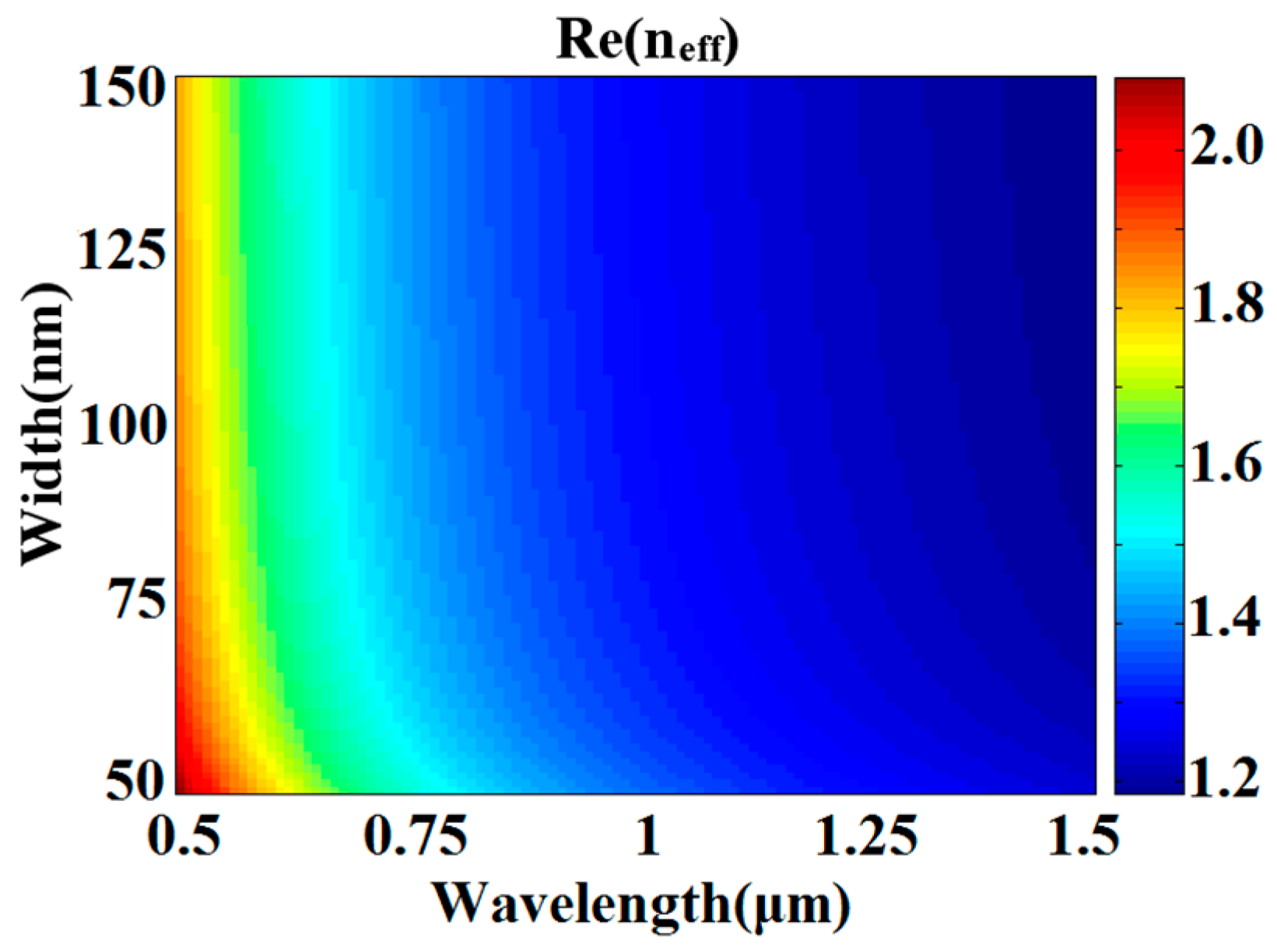
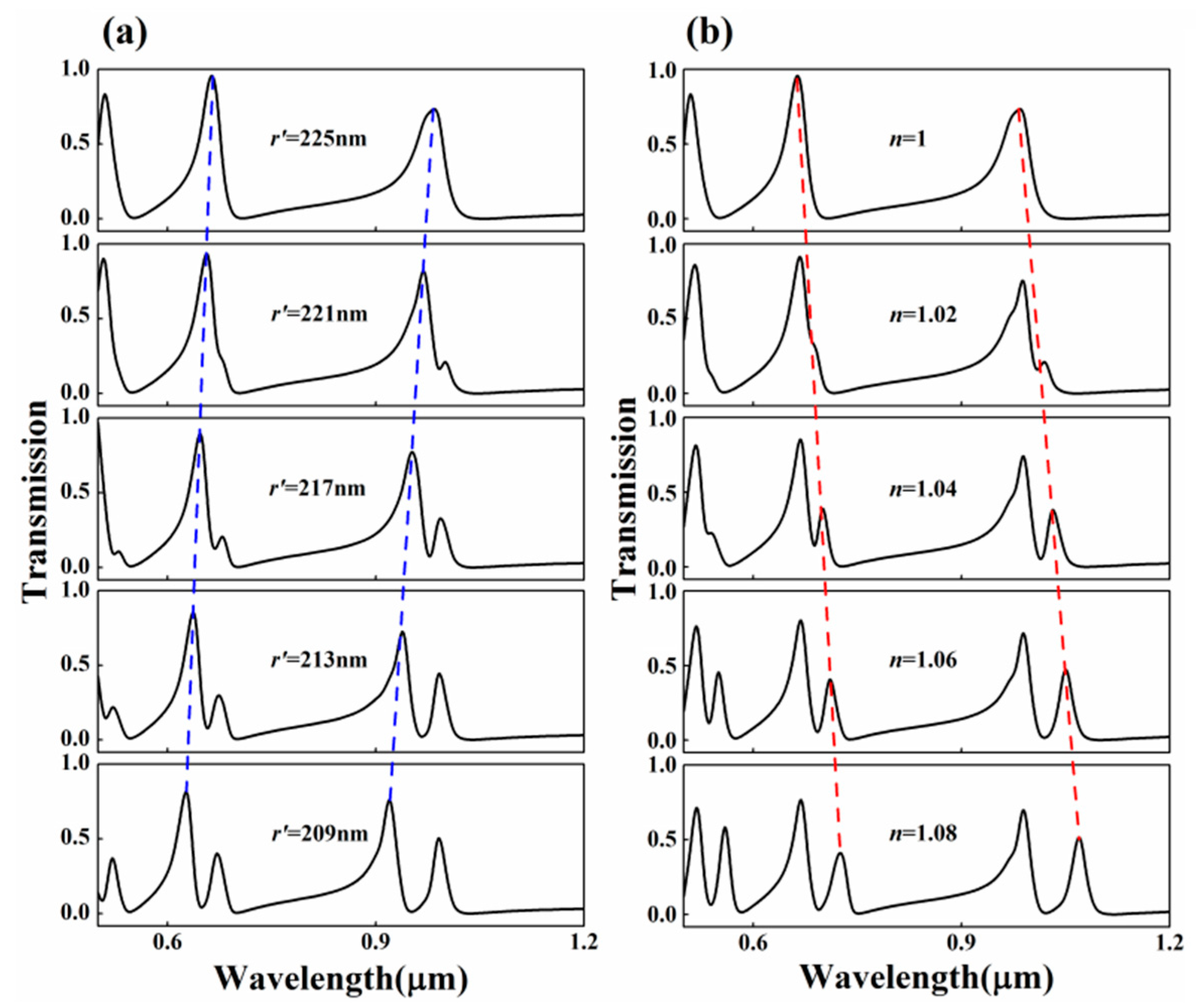

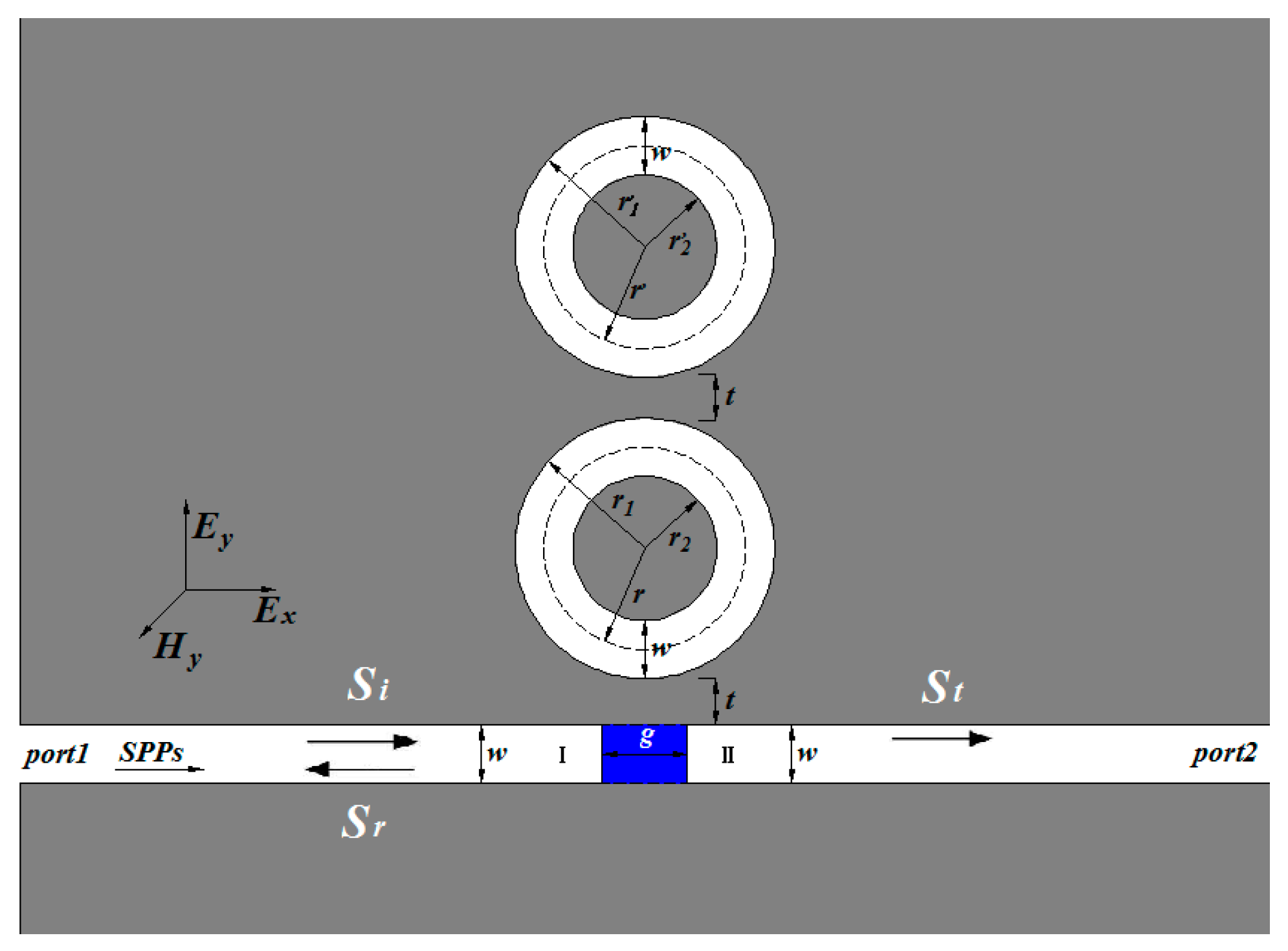
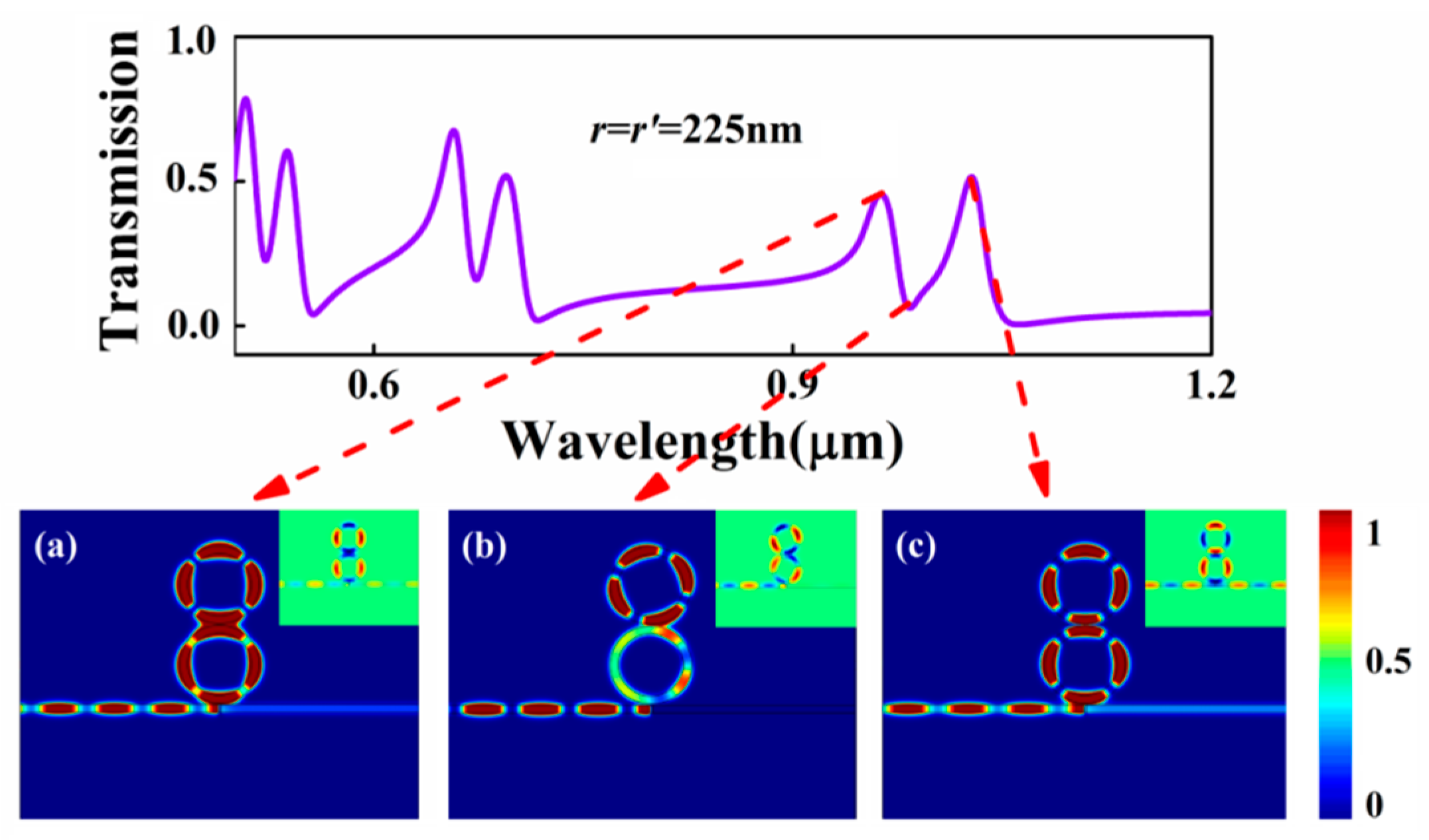
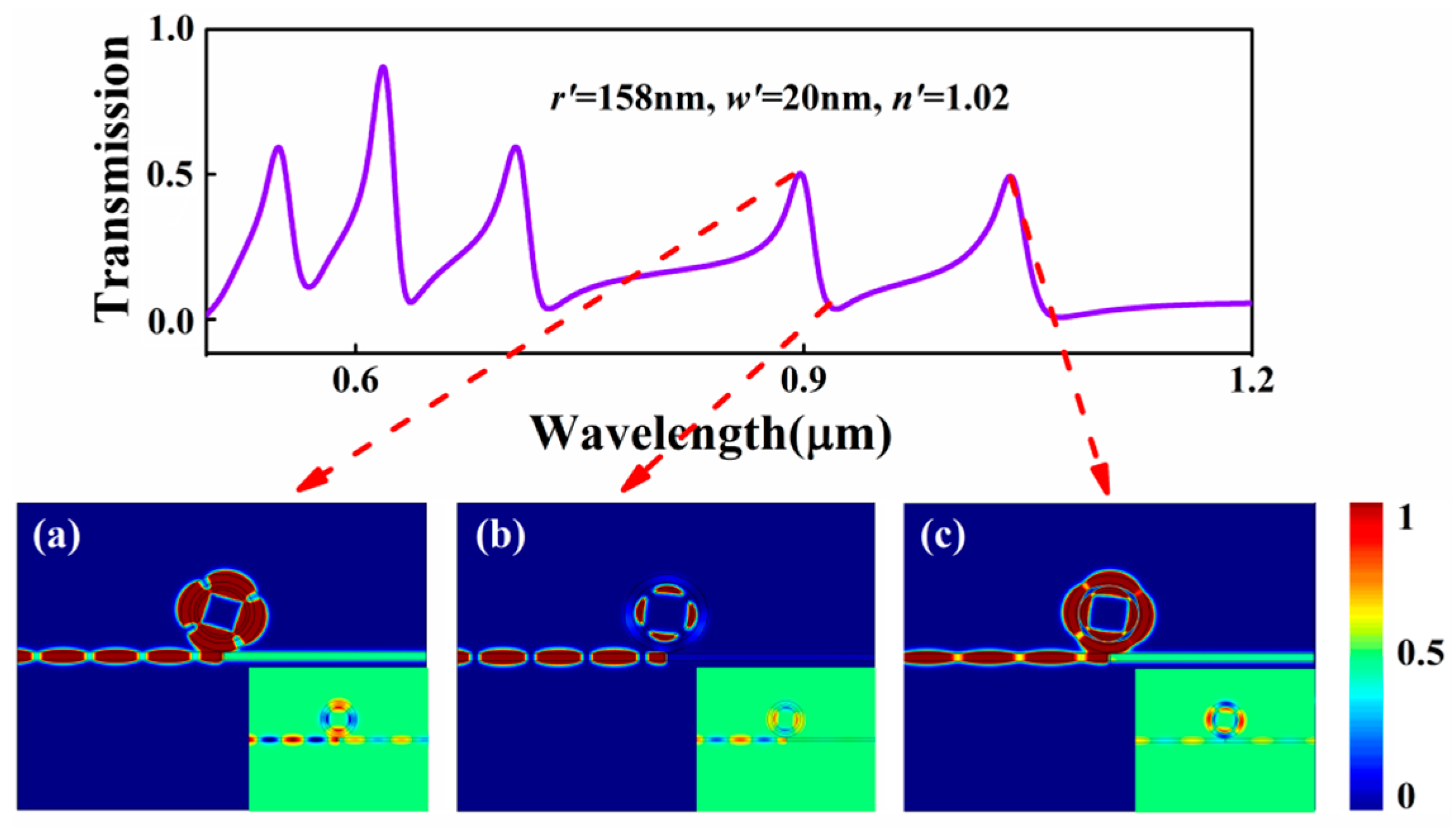
© 2017 by the authors. Licensee MDPI, Basel, Switzerland. This article is an open access article distributed under the terms and conditions of the Creative Commons Attribution (CC BY) license ( http://creativecommons.org/licenses/by/4.0/).
Share and Cite
Liu, D.; Wang, J.; Zhang, F.; Pan, Y.; Lu, J.; Ni, X. Tunable Plasmonic Band-Pass Filter with Dual Side-Coupled Circular Ring Resonators. Sensors 2017, 17, 585. https://doi.org/10.3390/s17030585
Liu D, Wang J, Zhang F, Pan Y, Lu J, Ni X. Tunable Plasmonic Band-Pass Filter with Dual Side-Coupled Circular Ring Resonators. Sensors. 2017; 17(3):585. https://doi.org/10.3390/s17030585
Chicago/Turabian StyleLiu, Dongdong, Jicheng Wang, Feng Zhang, Yuewu Pan, Jian Lu, and Xiaowu Ni. 2017. "Tunable Plasmonic Band-Pass Filter with Dual Side-Coupled Circular Ring Resonators" Sensors 17, no. 3: 585. https://doi.org/10.3390/s17030585




